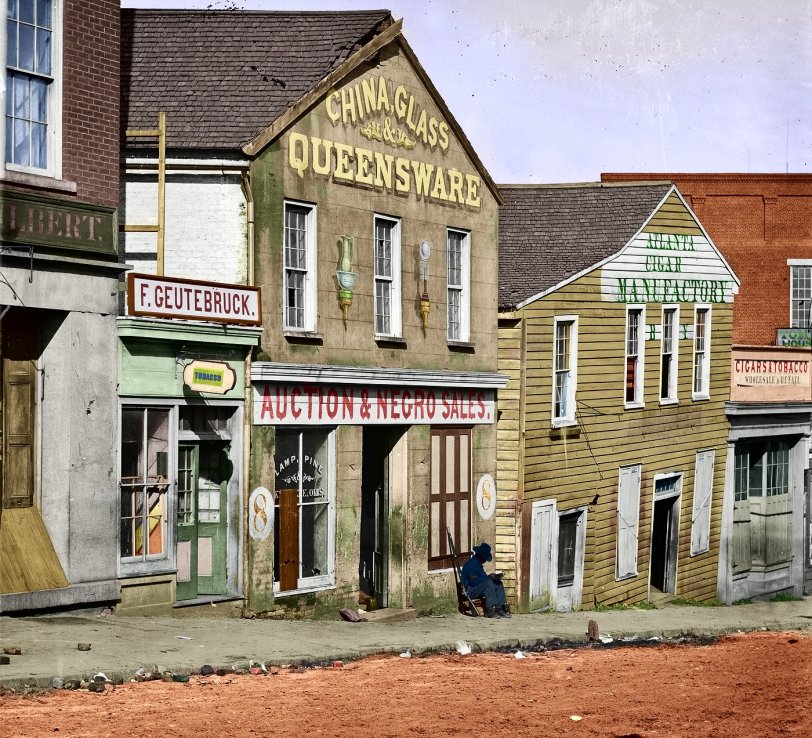


Framed or unframed, desk size to sofa size, printed by us in Arizona and Alabama since 2007. Explore now.
Shorpy is funded by you. Patreon contributors get an ad-free experience.
Learn more.

- Freeze Frame
- Texas Flyer wanted
- Just a Year Too Soon
- WWII -- Replacing men with women at the railroad crossing.
- Yes, Icing
- You kids drive me nuts!
- NOT An Easy Job
- I wonder
- Just add window boxes
- Icing Platform?
- Indiana Harbor Belt abides
- Freezing haze
- Corrections (for those who care)
- C&NW at Nelson
- Fallen Flags
- A dangerous job made worse
- Water Stop
- Passenger trains have right of way over freights?
- Coal
- Never ceases to amaze me.
- Still chuggin' (in model form)
- Great shot
- Westerly Breeze
- For the men, a trapeze
- Tickled
- Sense of loneliness ...
- 2 cents
- Charm City
- What an Outrage
- Brighton Park
Print Emporium
A Dark Chapter, in Color

Maybe seeing a scene from the slavery era in color will remind us of how very real those times were. Here's my concept of how this scene might have looked.
A marvelous job with a tough image.
Nicely done. Georgia dirt is nearly impossible to colorize (at least for me). It comes in all sorts of shades from bright red to orange to brown – and it changes color based on moisture and heat. At times – like in the dry fall months when this was taken – it dries to a very light –almost white - brown (like baked clay). In reality, the signs and wood would have been nearly devoid of pigment. By the summer of 1864 the south – poor in the best of times – had been existing under the most severe privation and these buildings had been neither painted nor whitewashed in many years. The wood would have been a dark, weathered grey. The brick building at the far right is the Concert Hall, and it sat right up against the main line of the railroads. Years of steam and southern humidity would have made the 365-days-a-year of heavy smoke and pine soot penetrate every crevice of the masonry. The mildew is a nice touch. (I really don’t mean to be critical at all; you’ve done a marvelous job with a tough image.)
Newsletter
> Mike Brown, sure you can use this photo in your
> newsletter, if it's OK with Dave. I'd like to
> see it when it's published. Is there any way I can?
Most of our members get it in PDF form, so it'll be easy. E-mail your address to wb2jwd@htva.net, and I'll be happy to send it along.
Thanks
Palm Springs John, I never considered that the street dirt should be clay-colored. I've changed it and replace the photo with the upgraded version. Is this more accurate? Too much red? I don't live in the South, so let me know if it's accurate yet.
Mike Brown, sure you can use this photo in your newsletter, if it's OK with Dave. I'd like to see it when it's published. Is there any way I can?
Thanks for your comments.
You know what they say --
"Those who do not remember the pastel are condemned to repeat it."
Seems so immediate
Exceptional work again, Fredric. The well chosen colors make the past seem so much more immediate, to color-accustomed eyes.
(Before photography, did anyone dream in black and white?)
Amazing!
I agree completely. When you look at old black and white photographs it's hard to believe we are seeing scenes from the past that were once completely real and colorful and full of life. It's like seeing an old movie; one tends to believe that "old timers" lived in black and white only, or that their presence is in some level unreal, as false and fictitious as the strange grayscale we see on the scene.
But things change dramatically when you see the same scene in full color! Suddenly the old, impersonal buildings and streets come to life, speaking to the viewer of a circumstance and a period of time that, its antiqueness notwhistanding, is as real as our current cotidianity. The bizarre, Kafkaesque scene becomes human again; the buildings stop being props or mere silhouettes and become the work of men; and the ads and messages painted on their walls speak again of the reality current when the photo was taken. We are transported in time; our eyes are privileged to see a scene that had not been truly seen by anyone in over 140 years. You see the scene and wonder: how different will things be 140 years from now? How our great-grandchildren react when they see a plain, two-dimensional image of our era? will they be awed by the simple little facts of daily life captured in that image, will they have the same sentiment of longing we experience at seeing this old relics of a bygone past?
What more to say? An excellent job, definitely blends artistic ability with technological improvements. Thank you very much for sharing it with us!
Beautiful work!
Seems very real; especially the stained and moldy wood and brick sidings; North facing I suspect. Having lived in Atlanta for many years, I think the dirt streets might be a touch more orange in color due the red clay so ever present in Georgia. Great job!
Great Work
It's amazing how the fact that all Civil War photography was black and white makes the era seem less real. I have seen CW pictures which were hand-painted in the 19th century, and they still have that unreal look, not at all like modern colorization.
May I have permission to use this image in our local Civil War Roundtable newsletter?
























On Shorpy:
Today’s Top 5